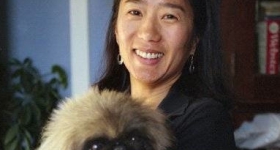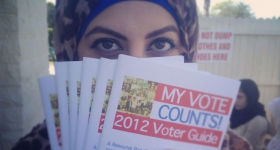American Book Award Winner Karen Tei Yamashita's latest novel, I Hotel, is a documentary-style look at the 1960s Yellow Power Movement.
ON A FRIDAY evening in San Francisco’s Manilatown Heritage Center, Karen Tei Yamashita prepares to read from her new novel I Hotel (Coffee House Press). It is standing-room only and the warm greetings, embraces and conversations indicate that this is not simply a literary event but a reunion of old friends and activists.
Yamashita scans the room, nodding at familiar faces. She smiles and then apologizes. “I’m sorry,” she says to the crowd. “I’m sorry I couldn’t tell all of your stories in the book.”
It is fitting Yamashita should launch I Hotel at the same exact spot where, over three decades ago, thousands of activists fiercely protested the eviction of elderly Filipino, Chinese and Japanese residents. The International Hotel, now the site of Heritage Center, is the nucleus of Yamashita’s latest literary feat.
Similar to her other novels — Brazil-Maru, which examines Brazil’s sizable Japanese immigrant communities, and Tropic of Orange, in which a multiethnic crew of Los Angeles citizens undergo a chaotic series of events — I Hotel draws upon extensive interviews and uses multilayered narratives to tell the story of the Asian American, or Yellow Power, movement.
I Hotel is divided into 10 novellas, or “hotels,” which each focus on a single year, locale and lives of three characters. In the novel’s afterword, Yamashita describes her research as “scattered across political affinities, ethnicities, artistic pursuits — difficult to coalesce into any one storyline or historic chronology.”
The daughter of two Northern California Democrats, Yamashita was raised primarily in the Japanese American community of Gardena, CA. It was in Los Angeles that she began the research for I Hotel, documenting the work of Asian American activists in the early 1990s with the filmmaker and Amerasia Journal designer Mary Kao. In 1997, when Yamashita became a professor of literature at the University of California, Santa Cruz, she realized the San Francisco Bay Area was at the red-hot center of the Yellow Power Movement and she began to focus her interviews and archival research on this region.
When Yamashita began her interviews in the late 1990s, the International Hotel was but a “hole in the ground.” Initial evictions of hotel tenants in 1968 were followed by a decade-long struggle to halt encroaching developers and re-establish the hotel as low-cost housing. At this time, Yamashita surrounded herself with such figures as poet Al Robles, former members of the International Hotel Tenants Association and Filipino farmworker activists in Delano, CA — all people who wanted to, as Yamashita says, “revive the memory of the hotel” and “[keep] the dream alive.”
In a period of over 10 years, Yamashita amassed over 150 interviews. “I had to figure out where the pain was,” Yamashita says.
The interviews became the basis for the characters in I Hotel and the diversity of voices lend an alarmingly realistic glimpse into the volatile 1960s. “Everyone was there, really there,” Yamashita says in her afterword.
Along with the International Hotel, the novellas are also set at San Francisco State University and the University of California, Berkeley — where turbulent student protests over the establishment of an ethnic studies program took place. Characters include a saxophonist just released from prison for his involvement in a student protest against a “fascist administration at San Francisco College” and a Filipino chef (and member of the Agricultural Workers Organizing Committee) who claims he once baked tarts for John Steinbeck.
While she captures an extraordinary range of personalities in I Hotel, Yamashita also employs a mind-boggling range of styles and genres. Parts of each novella are broken up into radio broadcasts, transcripts of documentary film, poetry, numbered lists — even dance choreography. At one point, comic panels (drawn for the novel by Sina Grace) satirically illustrate a Chiquita banana mothering a pair of Siamese twins, one being Anna May Wong and the other Suzie Wong.
The variety in narrative structures enabled Yamashita to more accurately document what Asian Americans created during the Yellow Power Movement. “There were all sorts of new strategies for activism and also for recounting events from the point of view of people on the ground,” she says. The final eviction of the International Hotel tenants, for example, is related in a cacophonous radio transcript of police removing the elderly tenants against the backdrop of ear-splittingly fierce protests.
The high-velocity realism of I Hotel reflects the volatile and explosive temperament of the Yellow Power Movement, what Yamashita described as “rejecting the impotence of being immigrants.” At a time when Arizona lawmakers have banished the teaching of ethnic studies in public schools and the Texas Board of Education has approved textbooks dramatically underplaying the contributions and oppression experienced by people of color, I Hotel is a potent throwback to an era when Asians established their identities, not simply, Yamashita writes in the final chapter of I Hotel, as “sojourners, immigrants, FOBs, refugees, exiles,” but as Asian Americans who “forever embed this geography with our visions and voices.”
Today, the Asian American Civil Rights Movement is entrenched in our way of thinking about race in America, but “we don’t know it anymore.”









Comments